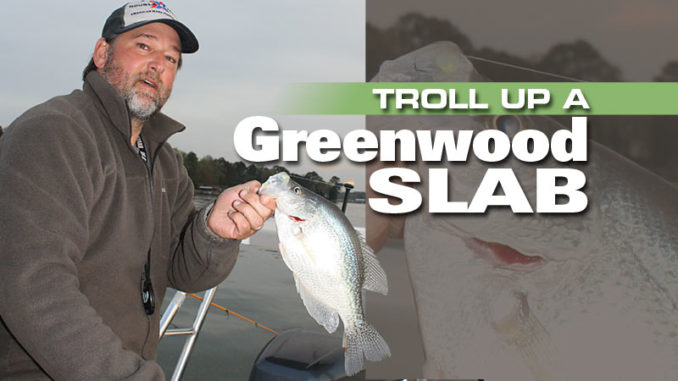
The spring spawn brings this South Carolina lake’s crappie to the forefront. Here’s how to drag dozens of baits in front of their noses.
When the water temperature reaches the mid-50s with favorable weather, hordes of small boats ranging from center consoles splaying 16 rods across their sterns to small john boats dragging but a few lines, congregate to slow-troll productive Lake Greenwood, trying to catch a cooler full of slab-sized crappie.
Most anglers equate crappie fishing with casting to brush piles and structure in shallow water near the shoreline. But in the early season, many Greenwood regulars go for big numbers by trolling with lots of rods, reminiscent of summertime offshore fishing but on a much smaller scale.
Use as many, or as few, rods as you’d like
As is the case with most of the Carolinas’ most-popular gamefish species, almost anybody can catch a few crappie during the prime periods. That’s when the fish are all over the place, feeding like crazy and almost jumping into the boat. But it takes skill and lots of experience to manage multiple rods and consistently catch lots of fish without hanging up on bottom structure or crossing lines with the squadron of other boats trolling the same area.
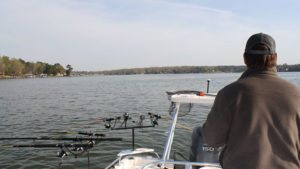
Russ Cason is one of those talented early season regulars frequenting Lake Greenwood. He has a lakeside home here, and shared some of the techniques for crappie trolling that work whether you opt for his mass attack approach, opt for dragging 4 to 8 rods from a john boat, or even a couple of rods in the hands of friends.
Crappie are in prespawn
Cason said the first trick is guessing where the fish will likely congregate and when they will arrive. He targets prespawn fish that are gorging themselves on minnows before heading to the banks to spawn. Action typically starts when the water gets to 55 to 59 degrees. This warming trend happens earlier in the upper parts of Lake Greenwood near where the Saluda and Reedy rivers meet. The water coming from the rivers is more sediment-loaded. So it warms sooner than other areas. Fishing remains productive in Greenwood from the early, prespawn action when it’s colder, until the water warms above about 78 degrees or about May 1, when the post-spawn action typically ends. The bulk of the spawning occurs in 65 to 75 degree water.
A good depth finder with GPS makes homing in on fish concentrations much easier. Cason looks for schooling bait fish on his electronics in about 20 feet of water as the focus for his trolling. The bait and feeding crappie are often holding at the 5- to 15-foot depth. With 16 rods spread across the stern, the 16-footers at right angles to the boat on each side; the 14-, 12- and 10-footers gradually moving aft, and six light rods pointing directly astern, he covers lots of water with a single pass.
Vary your line lengths
The lines, all 6- to 8-pound test monofilament, are presented at various lengths and all tipped with a light jighead. Common sizes include 1/8-, 1/16- or 1/32-ounce — and a small, soft-plastic curlytail grub or live minnow. Cason favors chartreuse curlytails, Southern Pro crappie lures in black, red and chartreuse and Charlie Brewer Slider grubs in black/chartreuse.
Cason trolls at 0.7 to 0.9 mph — his GPS lets him know how fast he’s moving — depending on the water depth. “If a line hangs up, just break it off,” he said. “Don’t slow down, or all the lines will hang up and you’ll have a real mess.”
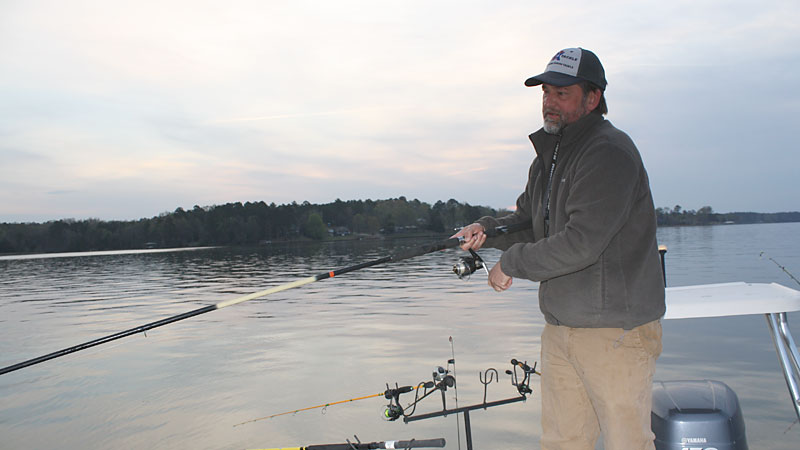
Pay close attention for subtle bites
When things are working and you cross a bait ball and get a strike from a crappie, it is surprisingly subtle, especially on the super long outside rods. After getting a strike, reeling in the fish to a waiting net is pretty simple. If you can avoid crossing other lines.
At 11,400 acres, Greenwood is a big lake, and there are plenty of places that hold spawning crappie in the spring, including creeks around Greenwood State Park, across from Goal Island and the upper reaches of Hidden Lake, an area behind a railroad trestle in a creek that enters the lake on the north shore, just downstream from the SC 72 bridge.
SCDNR has placed fish-attracting structures around the lake, marked by buoys with the GPS coordinates listed on the SCDNR website and the Fishing Hot Spot map. Locals often sink Christmas trees to attract fish.
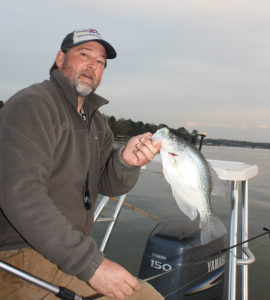
Cason said an ideal day is calm and mild with a stable temperature range for several days in a row. Greenwood is not known for really large crappie, but it holds lots of them. An 8-inch crappie weighs about a half-pound, and a 12-inch slab weighs about a pound. Cason often releases egg-laden females.
Once the water passes the 80-degree mark and the spawn is finished, fish move into their summer pattern and casting spinners, jigs or minnows to deep structure, brush piles, steep banks and shorelines is productive.
Greenwood’s crappie population is managed by a 20-fish daily creel limit, with an 8-inch size minimum.
DESTINATION INFORMATION
HOW TO GET THERE — Lake Greenwood is impounded by a dam on the Saluda River near Chappells, S.C. It likes in Greenwood, Laurens and Newberry counties. The lake has numerous boat ramps, including Harris Landing in Laurens County, Greenwood State Park in Ninety Six and The 45 at the SC 72 bridge near Waterloo.
WHEN TO GO — The crappie spawn on Lake Greenwood in March, April and May in water between 55 and 80 degrees. Look for baitfish and crappie holding in 5 to 15 feet of water, either waiting to move shallow to spawn or moving back out after finishing the spawn. Use tiny jigs, 1/8-, 1/16- or 1/32-ounce, tipped with soft plastics or live minnows.
BEST TECHNIQUES — Slow-trolling crappie jigs in a long-lining setup, with up to 16 rods in a spider-type pattern from the stern.
FISHING INFO/GUIDES — Anthony Davis, 803-356-2286; The Crappie Hole, Chapin, 803-345-5606, Hunters Headquarters, Greenwood, 864-223-1911. See also Guides & Charters in Classifieds.
ACCOMMODATIONS — Moon Landing RV Park and Marina, Cross Hill, 864-998-2492; Lighthouse RV Park and Marina, Cross Hill, 864-998-3500; Greenwood Chamber of Commerce, 222.greenwoodscchamber.org.
MAPS — Fishing Hot Spots, 1-800-ALL-MAPS, www.fishinghotspots.com.
Crappie: From the hook to hot grease
Who doesn’t like fried fish? Along South Carolina’s coast, fried flounder is often the choice, but for inland anglers, fried crappie or bream is the standard.
Most every crappie or bream fisherman has a favorite recipe, but during the spring spawn, these fish are so plentiful that eating them the same way all the time can get boring.
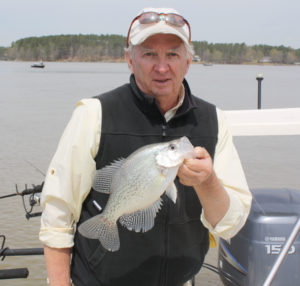
The most-common preparation is deep-fried, skinless fillets in peanut oil. Fillets are generally dusted in flour and/or corn meal and seasonings. Dozens of recipes share a combination of some or all of the following ingredients: all-purpose flour, corn meal or corn flour, garlic powder, cayenne pepper, buttermilk and others.
Some suggest soaking the fish overnight in saltwater, which firms the flesh. The result is a simple, thin-crusted flaky delight. Adding some beer battering and possibly an egg dip to the same process, and you get a fillet with a thicker crust.
Add tartar or cocktail sauce
Another old-fashioned favorite is whole crappie, bream or white perch scaled, gutted and headed and deep fried in a black, cast-iron pan. Scoring the flesh vertically with a sharp knife allows more thorough cooking and more taste of the coating. Again, soaking them in cold, saltwater firms the flesh.
Frying fish with very little oil, called sautéeing, produces a much lighter taste that is preferred by some. Pat dry, salt and pepper the fillets and press on some chopped herb and a drizzle of lemon juice, then sauté them with just enough olive oil or butter so they do not stick to the pan. Try any of these herbs: tarragon, dill weed, basil, marjoram.
Baking also produces a lighter fillet than deep frying. Fillets can be sprinkled with herbs, cheese, lemon juice, bread crumbs, butter or olive oil.
Fried crappie are wonderful with tartar or cocktail sauce on the side.

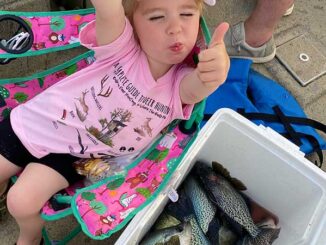
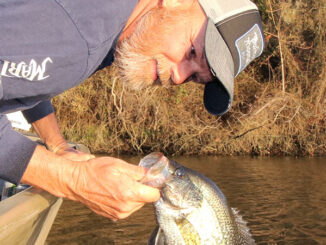
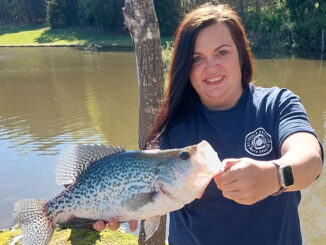
Be the first to comment